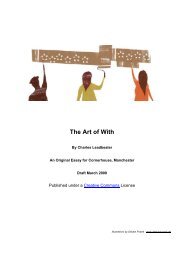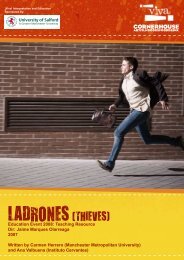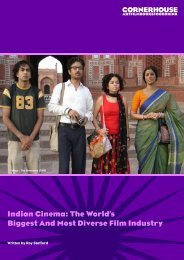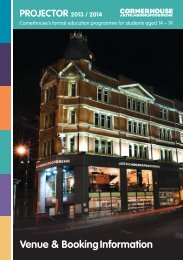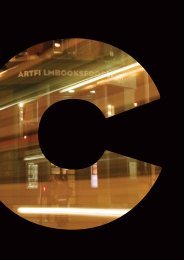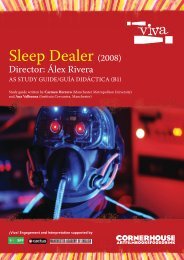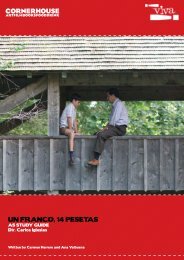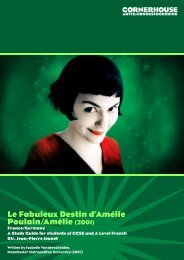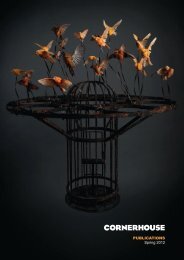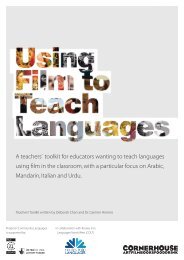Essential Intro to Film Studies Course Outline 2011 - Cornerhouse
Essential Intro to Film Studies Course Outline 2011 - Cornerhouse
Essential Intro to Film Studies Course Outline 2011 - Cornerhouse
You also want an ePaper? Increase the reach of your titles
YUMPU automatically turns print PDFs into web optimized ePapers that Google loves.
<strong>Essential</strong> <strong>Intro</strong>duction <strong>to</strong> <strong>Film</strong> <strong>Studies</strong>Starts Tue 11 Oct <strong>2011</strong>18:30 – 20:308 weeksHow do we start making sense of movies? Can we identify the various elements ofcinema which combine <strong>to</strong> form a film’s meaning, and can we start <strong>to</strong> talk about how filmworks? This is what this course sets out <strong>to</strong> cover, and its aim is <strong>to</strong> give you a workingvocabulary of key film concepts so that you can express what you think about film in aninformed and structured way. You will be introduced <strong>to</strong> the concept of mise-en-scene –literally, what’s ‘put on screen’: things such as design, costume, lighting etc tend <strong>to</strong> signifycertain things <strong>to</strong> us, and clue us in<strong>to</strong> the dramatic world of the film. Acting styles can alsocreate effects for us, and the presence of a familiar star in a film will carry additional layersof possible meanings for us.Cinema<strong>to</strong>graphy, <strong>to</strong>o, is expressive: where the camera is positioned, whether it moves,how it moves – these all affect us. Most films are composed of thousands of shots – sohow and why a film is edited is important. And, of course, even ‘silent films’ are projectedwith accompanying music, so we need <strong>to</strong> think about how sound (effects, speaking,music) are used <strong>to</strong>o.Once we have explored these elements of ‘film language’ we will examine how filmnarratives are constructed, and will ask whether films are ‘narrated’ <strong>to</strong> us. The idea of‘genre’ can help us ‘de-code’ how a particular film is operating (genres also help theindustry <strong>to</strong> market their products).As part of this course, there are two screenings at <strong>Cornerhouse</strong>. The first is in week 3,and it is one of the greatest of Hollywood musicals, Singin’ in the Rain. As it is a film aboutthe film industry itself, it will give us lots <strong>to</strong> talk about. The second film is MartinScorsese’s Goodfellas – visually and aurally, an extremely rich and complex gangstermovie.Above all, this course aims <strong>to</strong> enhance your enjoyment of film, by giving you some <strong>to</strong>ols <strong>to</strong>talk about film in a structured and insightful way. Handouts and further readingsuggestions will be provided during and at the end of the course.All tu<strong>to</strong>r-led course sessions will take place in The Annexe and there will be twoscreenings in our cinemas.Beginners' level – no prior knowledge required.Tu<strong>to</strong>r: Andy Moor, Reader in Cinema His<strong>to</strong>ry at Manchester Metropolitan UniversityWeek 1Tue 11 Oct18:30 – 20:30<strong>Intro</strong>duction: What the camera doesWe begin with an overview of the various elements we willlook at in more detail as the course progresses, asking thegeneral question ‘can we think of cinema as a type oflanguage?’ Many films, of course, lure us in<strong>to</strong> their s<strong>to</strong>ryworldsso that we forget about the technology which hasThe Annexe
Week 2Tue 18 Oct18:30 – 20:30Week 3Tue 25 Oct18:30Week 4Tues 1 Nov18:30 – 20:30Week 5Tue 8 Nov18:00mediated what we see – not least the camera itself.We will therefore start <strong>to</strong> consider where the camera hasbeen placed: why use a long-shot, or a close-up? Howmight a camera be moved within a shot? And why?What’s in the Shot: Mise-en-scèneMise-en-scène – literally, ‘what’s put on screen’ – meanseverything visible within the frame of a shot. Itencompasses setting, location, props, lighting, makeup,gesture and (of course) acting. We will consider howdifferent types and combinations of these affect themeaning of a shot, and think how different genres of filmtend <strong>to</strong> have a particular palette of elements which weimmediately recognise.<strong>Film</strong> Screening: Singin’ in the Rain (U)Dir Gene Kelly, Stanley Donen / US 1952 / 103 minsJean Hagen, Donald O'Connor, Debbie Reynolds,Gene Kelly, Cyd CharisseSet in Hollywood at the end of the silent era, SINGIN’ INTHE RAIN tells <strong>to</strong> s<strong>to</strong>ry of newcomer ac<strong>to</strong>r (Reynolds) asshe meets the star, Don Lockwood (Kelly), and makesgood both on screen and in his arms in this sweet showbizs<strong>to</strong>ry set during the birth of talkies.Sound & The MusicalIt seems a good idea <strong>to</strong> draw on what we’ve looked at sofar and <strong>to</strong> think about how last week’s film works.One aspect of cinema which motivates the s<strong>to</strong>ryline ofSingin in the Rain is sound – in particular, synchronisedsound. We will cover ideas about the use of sound andmusic in film – and also consider what form the musical –as a genre – can take.We will end by looking forward <strong>to</strong> next week’s film, MartinScorsese’s Goodfellas.Screening: Goodfellas (18)Dir Martin Scorsese / US 1990 / 145 minsRobert De Niro, Joe Pesci, Ray Liotta, Lorraine BraccoScorsese’s outstanding rise and fall s<strong>to</strong>ry of mobsterHenry Hill, a half-Irish, half-Sicilian kid who grows upidolising the Mafia big shots in his impoverished Brooklynneighborhood. After taking on a job at the local cab stand,Henry is soon introduced <strong>to</strong> veteran criminal JimmyConway and reckless delinquent Tommy De Vi<strong>to</strong>, andinitiated in<strong>to</strong> the world of the 1950s New York Mob. Basedon the true life best selling au<strong>to</strong>biography ‘Wiseguy’, byNicholas Pileggi, and backed by a superb soundtrack,The AnnexeCinemaThe AnnexeCinema
Week 6Tue 15 Nov18:30 – 20:30Week 7Tue 22 Nov18:30 – 20:30Week 8Tue 29 Nov18:30 – 20:30Goodfellas is remembered as one of the all time Scorsesegreats. Featuring an Oscar-winning performance from JoePesci as the petite but big headed De Vi<strong>to</strong>.To cut or not <strong>to</strong> cut: Editing choicesThe last ‘technical’ aspect we will look at is editing. Once afilm is composed of more than one shot, some editingdecision has been made. Using examples from Goodfellaswe will start <strong>to</strong> examine how some sequences have beenput <strong>to</strong>gether, and what effect the editing choices have hadon the finished product.We can, of course, also discuss the film in more generalterms: its design is stunning (but is it always ‘realistic’?); itsuse of music is different from the classical musical we sawearlier in the course; and its main ac<strong>to</strong>rs demonstrate verydifferent acting styles. Why? What are the significantfeatures of the gangster movie?Narrative and NarrationWe are used <strong>to</strong> the standardized feature film, though it isby no means the only form of cinema. How are narrativesconstructed? What forms of narratives predominate? Howdid classical Hollywood develop such a well recognizedform of narrative? Alongside these questions, are issues <strong>to</strong>do with how we find out what happens in films? Do weknow more than characters in a film itself? Is there anexplicit narra<strong>to</strong>r – perhaps with a voiceover – telling uswhat is happening? Is that narra<strong>to</strong>r someone we can trust?StarsBy way of a round-up, we will think about what stars areand how they <strong>to</strong>o function as elements in a cinematiclanguage. Do stars bring meanings with them? Do weimport ideas about particular stars when we watch theirlatest film? How do we relate <strong>to</strong> stars? And what’s thedifference between a star and an ac<strong>to</strong>r?The AnnexeCinemaThe AnnexeReferencesThere are lots of ‘introduc<strong>to</strong>ry’ books about film studies on the market, and many of themare very good. A lot of them are also rather expensive – certainly you do not need <strong>to</strong> buyany of these. However, if you want a solid colourful text book <strong>to</strong> immerse yourself in, thenthese are all good, and you might be able <strong>to</strong> find them 2 nd hand:• David Bordwell and Kristin Thompson, <strong>Film</strong> Art: An <strong>Intro</strong>duction• Jill Nelmes, <strong>Intro</strong>duction <strong>to</strong> <strong>Film</strong> <strong>Studies</strong>• Richard Barsam, Looking at Movies: An <strong>Intro</strong>duction <strong>to</strong> <strong>Film</strong>
Shorter, more portable books which are handy primers for those new <strong>to</strong> the study of filminclude:• Susan Hayward, Cinema <strong>Studies</strong>: The Key Concepts• Andrew Dix, Beginning <strong>Film</strong> <strong>Studies</strong>Dr Andy Moor, August <strong>2011</strong>Associated EventsNew British Cinema QuarterlyJunkhearts (CTBA)Tue 22 Nov, 18:20Dir Tinge Krishnan/GB <strong>2011</strong>/Running time TBCEddie Marsan, Romola Garai, Tom Sturridge, Shaun DooleyOur regular showcase of new British talent returns with a tense psychological thriller fromBAFTA award-winner Tinge Krishnan. Set in inner-city London, Junkhearts tells theemotional s<strong>to</strong>ry of a former soldier whose post-traumatic stress disorder leaves himvulnerable <strong>to</strong> exploitation.EventWe are pleased <strong>to</strong> welcome members of the filmmaking team for a post-screening Q&A.For more information on the New British Cinema Quarterly programme, visitwww.nbcq.co.ukMatinee ClassicsOur popular, ongoing programme brings cinema classics <strong>to</strong> the big screen every month –with each film showing on a Sunday at 12:00 and the following Wednesday at 13:30. OurOc<strong>to</strong>ber and November films will also have an informal post-screening discussionfollowing the Wednesday showing, so you can talk about the film with other film fans.The Lavender Hill Mob (U)Sun 23 & Wed 26 OctDir Charles Crich<strong>to</strong>n/GB 1951/81 minsAlec Guinness, Stanley Holloway, Sidney JamesCharles Crich<strong>to</strong>n’s hilarious caper comedy The Lavender Hill Mob celebrates its 60thanniversary this year, and this classic of Ealing Studios retains its <strong>to</strong>ngue-in-cheek charm.After years of servitude and drudgery, Henry Holland (played by Alec Guinness, who wasOscar-nominated for his performance) turns against his employer and hooks up with apair of career criminals <strong>to</strong> execute a spectacular gold heist.West Side S<strong>to</strong>ry (PG)Sun 6 & Wed 9 NovDirs Jerome Robbins, Robert Wise/US 1961/151 minsNathalie Wood, Richard Beymer, Russ Tamblynm Rita MorenoWinner of ten Oscar awards, this electrifying musical sets the ageless tragedy ofShakespeare’s Romeo and Juliet in the slums of 1950s New York. Teenage street gangThe Jets is preparing <strong>to</strong> fight rival Puer<strong>to</strong> Rican gang, The Sharks. After falling in love atfirst sight with the beautiful Maria, sister of The Sharks leader Bernardo, Jet co-founderTony tries <strong>to</strong> limit the weapons <strong>to</strong> fists, but the fighting soon gets out of control, withdisastrous consequences…
Gilda (PG)Sun 20 & Wed 23 NovDir Charles Vidor/US AR 1946/110 minsRita Hayworth, Glenn Ford, George MacReady, Joseph CaileiaRita Hayworth oozes star presence as the wife of a club owner who becomes embroiled ina ménage-a-trois with her dangerous husband and down-and-out gambler ex-lover whohas been hired <strong>to</strong> work the family club. This classic of Hollywood film noir bristles withsexual ambiguity, euphemism and innuendo played out <strong>to</strong> perfection by the stunningHayworth.The Shop Around the Corner (U)Sun 4 & Wed 7 DecDir Ernst Lubitsch/US 1940/98 minsJames Stewart, Margaret Sullavan, Frank MorganSet in a Budapest in the run-up <strong>to</strong> Christmas, this delicate comedy follows the obstaclesblocking the path of potential lovers Alfred and Klara, fellow workers in a gossip-riddenemporium, unaware that they are courting one another by mail in an anonymouscorrespondence. The inspiration behind Nora Ephron’s 1998 You’ve Got Mail, andpreviously unavailable in UK cinemas, this romantic s<strong>to</strong>ry is one of Hollywood’s mostexquisite depictions of old central Europe.White Christmas (U)Sun 18 & Wed 21 DecDir Michael Curtiz/US 1954/120 minsBing Crosby, Danny Kaye, Vera-Ellen, Rosemary ClooneyTwo talented song-and-dance men, pals during World War II, team up <strong>to</strong> become one ofthe hottest acts in show business. One winter, they join forces, romantically andprofessionally, with attractive sister act The Haynes Sisters and <strong>to</strong>gether they trek <strong>to</strong>Vermont for the perfect seasonal holiday. A heart-warming Christmas tale, featuring atreasury of Iving Berlin classic tunes, including of course ‘White Christmas’.<strong>Film</strong> QuizSo you think youʼre a movie buff? Want <strong>to</strong> have a fun evening with your friends but canʼtmake it <strong>to</strong> our weekly Monday night quiz? Then join us at our monthly <strong>Film</strong> Quiz whereyour movie knowledge will be tested <strong>to</strong> the limit. Expect questions on anything from TheBicycle Thieves <strong>to</strong> Short Circuit 2 – and much more besides!Our monthly <strong>Film</strong> Quiz is sponsored by Fopp. Top scorers can win a host of fantasticprizes from DVDs, books, CDs, film memorabilia and more!To find out more about the <strong>Film</strong> Quiz and other film events visithttp://www.cornerhouse.org/film/film-events/



